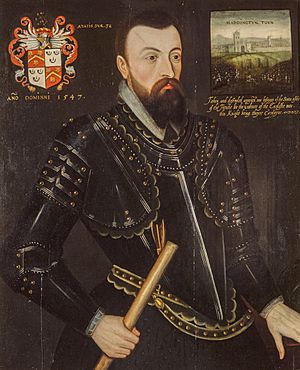James Wilsford facts for kids
Sir James Wilsford (born around 1516, died 1550) was an English soldier and a member of Parliament. He was a key commander during the Siege of Haddington, which was part of a conflict known as the Rough Wooing. He also served as a Member of Parliament for Barnstaple.
Contents
Who Was James Wilsford?
James Wilsford was born around 1516. His father was Thomas Wilsford, a landowner from Hartridge in Cranbrook, Kent. His mother was Elizabeth Culpeper. James was one of many children in his family. One of his brothers, Sir Thomas Wilsford, also became a well-known soldier and politician.
Fighting in Scotland
James Wilsford played an important role in the wars between England and Scotland.
The Battle of Pinkie Cleugh
He was a military police officer (called a Provost Marshal) at the Battle of Pinkie Cleugh on September 10, 1547. After this battle, he was made a knight. A writer named Ulpian Fulwell described Sir James in 1575, saying he was a great leader who won the hearts of his soldiers. He was kind and gentle with his friends, but like a lion when facing his enemies.
Commanding Haddington
In April 1548, Sir James helped manage the fort at Lauder, which is now the site of Thirlestane Castle. He was then chosen to lead the English and Italian soldiers who were holding the town of Haddington.
On June 3, 1548, Wilsford and Thomas Wyndham captured Dalkeith Palace. They burned the town and took James Douglas, who would later become Regent Morton, as a prisoner.
By November 1, 1548, Haddington was in a difficult state. Sir James wrote to Protector Somerset about the problems. Many soldiers were sick, and a large number had died from the plague. He explained that fewer than 1,000 soldiers were healthy enough to defend the town walls.
Captured by the Enemy
In January 1549, Sir James Wilsford was captured at Dunbar Castle. He was overseeing a supply convoy when he was taken prisoner by Robert Lauder of the Bass. A French soldier, Jean de Beaugué, also wrote about this event. Mary of Guise, a powerful Scottish leader, called his capture a "good catch."
Life as a Prisoner
After his capture, James Croft took over Wilsford's command at Haddington. In June 1549, Wilsford was held at Stirling Castle. The English Privy Council worked to arrange his release through a prisoner exchange. They saw him as a very important soldier who had served well, even though he was now "vexed with much sickness" (meaning he was very ill). They suggested exchanging him for the son of Lord Fleming. Wilsford was then moved to the care of Janet Stewart, Lady Fleming, and he was finally released around November 1549.
Later Life and Death
In early 1550, Wilsford was given control of the areas around Gravesend and Milton, and a park in Otford, Kent. He was granted these roles for his lifetime.
Sir James Wilsford died in November 1550. His funeral speech was given by Miles Coverdale. He was buried in London at St. Bartholomew's by the Exchange. A special metal plate from his tomb, showing his family's symbols, is now kept at the Museum of London.
His Family
Sir James Wilsford married Joyce Barrett. After his death, she quickly married Thomas Stanley. In 1553, Thomas Stanley became the guardian of Wilsford's only son, also named Thomas.
His Portrait
A portrait of Sir James Wilsford was painted, possibly by Hans Eworth. Four copies of this painting still exist today. Three of these paintings show a view of Haddington in the background. The portraits are dated 1547 and show Wilsford at age 32.


